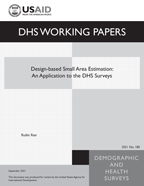- PUBLICATIONS
- JOURNAL ARTICLES
- ACCESS PUBLICATIONS
Publications Summary
- Document Type
- Working Papers
- Publication Topic(s)
- Fertility and Fertility Preferences, Geographic Information, Infant and Child Mortality
- Country(s)
- Rwanda
- Language
- English
- Recommended Citation
- Recommended citation: Ren, Ruilin. 2021. Design-based Small Area Estimation: An Application to the DHS Surveys. DHS Working Papers No. 180. Rockville, Maryland, USA: ICF.
- Download Citation
- RIS format / Text format / Endnote format
- Publication Date
- September 2021
- Publication ID
- WP180
Download
 Design-based Small Area Estimation: An Application to the DHS Surveys (PDF, 1998K)
Design-based Small Area Estimation: An Application to the DHS Surveys (PDF, 1998K)
Download this publication
There is no printed copy available to order.
